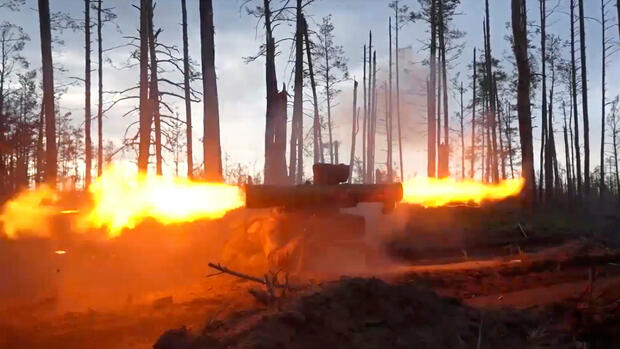Bonn Destroyed power plants, burning forests and apartment blocks lying in ruins: With its war of aggression in Ukraine, Russia is robbing people of their homes or even their lives. The focus is less often on what the war means for the climate – but the effects should not be underestimated.
A detailed calculation by international researchers comes to the conclusion: in the first year alone, the Ukraine war caused about as many emissions as a country like Belgium in the same period – namely 120 million tons of CO2 emissions equivalents. This means that the emissions of other climate-damaging greenhouse gases – such as methane – are converted into CO2 emissions in order to be able to compare them better.
“First and foremost, of course, it is a human tragedy,” says the leading Dutch climate researcher Lennard de Klerk in an interview with the German Press Agency. “But there is also major environmental damage.”
The scientist has lived in Moscow and Kiev in the past. When Russia invaded Ukraine, he asked himself: What can I do? He quickly realized that hardly anyone had dealt with the ecological footprint of wars – and got to work. At the UN climate negotiations in Bonn this Wednesday, he wanted to present what he had found out with an international team.
The experts estimate the proportion of emissions caused by direct combat operations at 19 percent of the total emissions in the first year of the war – the majority came from the fuel consumption of Russian troops in particular, but also Ukrainian troops. Similarly high emissions, according to de Klerk and his colleagues, also came from fires, which often break out near the front line — accounting for 15 percent, according to the estimate.
Most of the emissions after reconstruction
The majority of the emissions – namely around 50 million tons – are estimated for post-war reconstruction, when power plants, industry and buildings have to be rebuilt. The construction sector, in which a lot of concrete is processed, is generally one of those sectors with a very high emission of greenhouse gases.
The drinking water supply in the country is disrupted.
(Photo: AP)
In addition, the calculation also takes into account the leaks in the Nord Stream pipelines and the emissions caused by aircraft due to their long-distance detours via Asia since the sanctions against Russia came into force.
The recent destruction of the Kachowka dam clearly shows that the environmental damage is increasing day by day. UN Secretary-General António Guterres spoke of a human but also an “ecological catastrophe”. The drinking water supply is at risk. Ukrainian Foreign Minister Dymtro Kuleba also warned that his country was “facing a major humanitarian and ecological crisis”. For example, the irrigation system, which is important for agriculture in southern Ukraine, is affected.
The British mathematician Stuart Parkinson, who heads the organization Scientists for Global Responsibility, has been trying for years to get to the bottom of the role of the military in the climate crisis – and repeatedly encounters hurdles. “There are huge gaps in the data,” he says in an interview with the German Press Agency.
“A lot of data is confidential.” It is long overdue for the military to make its way towards climate neutrality, because: “Military investments are designed for decades.” The EU, Great Britain and the USA want to become climate-neutral by 2050.
Military and climate crisis
“It’s a blind spot for anyone doing climate research,” agrees Dutchman de Klerk. In the past, the military had little interest in the climate, even though climate change had a decisive impact on its activities.
The military is slowly becoming aware that the armies also have to adapt. But the process is still in its infancy. The fact that fighter jets or tanks can be operated on a large scale with climate-neutral fuels is a dream of the future.
Four years ago, military representatives and experts from the USA, France and the Netherlands, among others, came together to work out how the military should deal with the climate crisis.
In a report published last year, the group that calls itself the International Military Council on Climate and Security (IMCCS) states that there is no standardized way of measuring greenhouse gas emissions from armies at all. The military is excluded from the Paris climate protection agreement. So far, there has often been concern that too much transparency could strategically weaken armies.
This is how the Handelsblatt reports on the Ukraine war:
The group calls on NATO and the EU to work together and set common standards. NATO is important for establishing standards and the EU must include the military in its “Green New Deal”.
More: You can find the latest developments in our news blog on the Ukraine war
